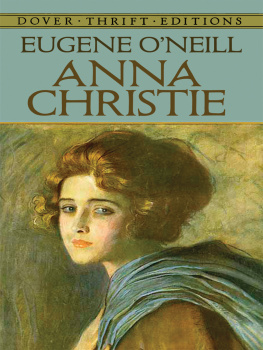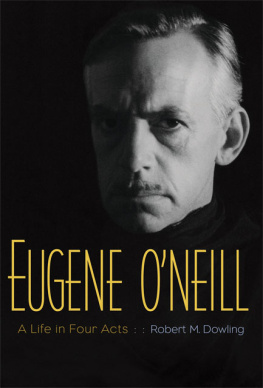

BRIGHT NOTES: The Major Plays of Eugene ONeill
www.BrightNotes.com
No part of this publication may be used or reproduced in any manner whatsoever without written permission, except in the case of brief quotations in critical articles and reviews. For permissions, contact Influence Publishers http://www.influencepublishers.com.
ISBN: 978-1-645424-44-4 (Paperback)
ISBN: 978-1-645424-45-1 (eBook)
Published in accordance with the U.S. Copyright Office Orphan Works and Mass Digitization report of the register of copyrights, June 2015.
Originally published by Monarch Press.
David Madison Rogers, 1965
2020 Edition published by Influence Publishers.
Interior design by Lapiz Digital Services. Cover Design by Thinkpen Designs.
Printed in the United States of America.
Library of Congress Cataloging-in-Publication Data forthcoming.
Names: Intelligent Education
Title: BRIGHT NOTES: The Major Plays of Eugene ONeill
Subject: STU004000 STUDY AIDS / Book Notes
CONTENTS

EUGENE ONEILL
INTRODUCTION
EARLY LIFE
Eugene ONeill was born in a Broadway hotel on October 16, 1888. His father was a popular actor of romantic melodrama and Eugenes first seven years were spent in the larger towns all over the United States. The success of the Count of Monte Cristo , in which his father played the lead, kept the family engaged in almost continuous road tours. From the age of seven to thirteen he attended boarding schools. In 1902 he was sent to Betts Academy at Stamford and the autumn after his graduation he entered Princeton. Although his parents were Catholic, and he had been in and out of parochial schools from an early age, by the time he entered Princeton he had left the Church and never returned to it.
DISCONTENT WITH COLLEGE
In June of 1903 he was dismissed from Princeton, supposedly for throwing a beer bottle through a window of President Wilsons house. He could have returned the following year, but he had become bored with college and left to become a secretary in a New York mail-order house, the first in a long series of jobs he held before settling down to write.
YEARS OF WANDERING
In 1909 he married Kathleen Jenkins, a union that ended in divorce in 1912. In the same year he went on a gold-prospecting trip to Honduras. He had been reading Jack London, Kipling and Conrad, and we can see in the many journeys of his youth a desire to lead the rugged life of adventure that those writers took as their central theme . In 1910 he shipped on a Norwegian barque for Buenos Aires where he worked at some odds jobs, but ended up, in his own words, a bum on the docks. In 1911, after a trip to Africa on a cattle steamer, he returned to New York where he lived at Jimmy the Priests, a waterfront dive which provided the setting for the first act of Anna Christie . After a last voyage to England he found himself on a train to New Orleans following a wild party. His father was playing there in the perennially popular Monte Cristo . He refused to give his son a handout, but did give him a part in the play. At the close of the season the ONeills returned to their summer home in New London, Connecticut, where Eugene worked as a cub reporter on the Telegraph .
HIS DESIRE TO WRITE
In December of 1912 ONeill entered a tuberculosis sanatorium. Weakened by years of irregular living, his health had broken down. During his fifteen month convalescence he first felt the urge to write. When he left the sanatorium he was a man with a purpose. To rebuild his health he disciplined himself to a life of exercise and hard work. In the next sixteen months he wrote eleven one-act plays, two long plays, and some poetry. He read omnivorously, in his own words the Greeks and Elizabethans-practically all the classics - and of course all the moderns.
FIRST PLAYS
In the fall of 1914 he went to Harvard to take Professor George Bakers famous course in playwriting. In the same year his father financed the publication of his first book, Thirst and Other One-act Plays . Several plays in Thirst take men against the sea as their theme . ONeills classic statement of his theme is in the so-called Glencairn group, a sequence of one-act plays dealing with the tramp steamer Glencairn. The group consists of The Moon of the Caribbees, Bound East for Cardiff, The Long Voyage, Home and In the Zone . In these plays man is shown in conflict with nature, which is indifferent to his suffering and inevitable doom. In his early naturalism ONeill was deeply indebted to Jack London.
FIRST SUCCESS
In 1916 the Provincetown Players put on Bound East for Cardiff . It was ONeills first play to be acted. The Players were a group of Greenwich Village journalists, writers and painters who were interested in rejuvenating the American theater. In 1917-18 he had three plays published in Smart Set , a magazine of protest against the self-satisfied middle class, whose editors, H. L. Mencken and George Jean Nathan, were already known as literary critics. The production of Beyond the Horizon in 1920 brought ONeill his first Pulitzer Prize, and from then until his death no one seriously questioned that he was the leading American playwright of his generation. In 1918 he had married Agnes Boulton Burton, and now, riding the wave of success, he had great faith in the future. However, he resolved he would never sell out to success. His father had felt that the temptation of easy money to be had from a play such as Monte Cristo had ruined his chances of becoming a fine actor. ONeill resolved he would remain true to his dream and work to express the truth he had in him.
DISILLUSIONMENT
In spite of his remarkable success, ONeill was convinced that bad fortune was hounding him. Throughout his life, except for brief periods, he had the feeling that man is at the mercy of mysterious forces beyond his control. He began to look back with nostalgia upon his seafaring days, and longed to be on the move again.
FINANCIAL SUCCESS
In the fall of 1920 The Emperor Jones was staged in London, Paris, Berlin, Tokyo and Buenos Aires, laying the foundation for ONeills international reputation. One year later Anna Christie opened in New York and brought him his second Pulitzer Prize. In 1922 The Hairy Ape was a success. It dramatized the idea that man has lost his old harmony with nature and is out of place in the modern, technological world. Late in 1922 ONeill was making $850 a week in royalties. He bought a farm at Ridgefield, Connecticut, and settled down to live in landed elegance as his father had always desired to do.
HIS PESSIMISM
However, ONeill could not settle down and two years later he was living in Bermuda and working on the idea for Mourning Becomes Electra . His idea of man at the mercy of mysterious forces had broadened through his reading of Freud, a German psychologist (1856-1939), Nietzsche, a German ethical writer who detested Christianity (1844-19000), and Schopenhauer, a German philosopher of the romantic period (1788-1860). From Freud he took the idea of man trapped by his unconscious sexual desires. Schopenhauers pessimistic philosophy reinforced the naturalistic determinism that had been fostered by his reading of London and Conrad, and his own erratic life. From Nietzsche he took a joyous acceptance of despair as the only sane attitude for a man faced with an indifferent universe.
Next page












